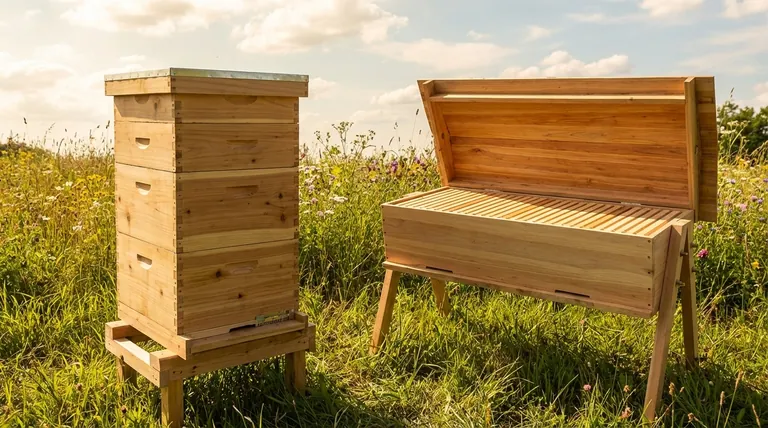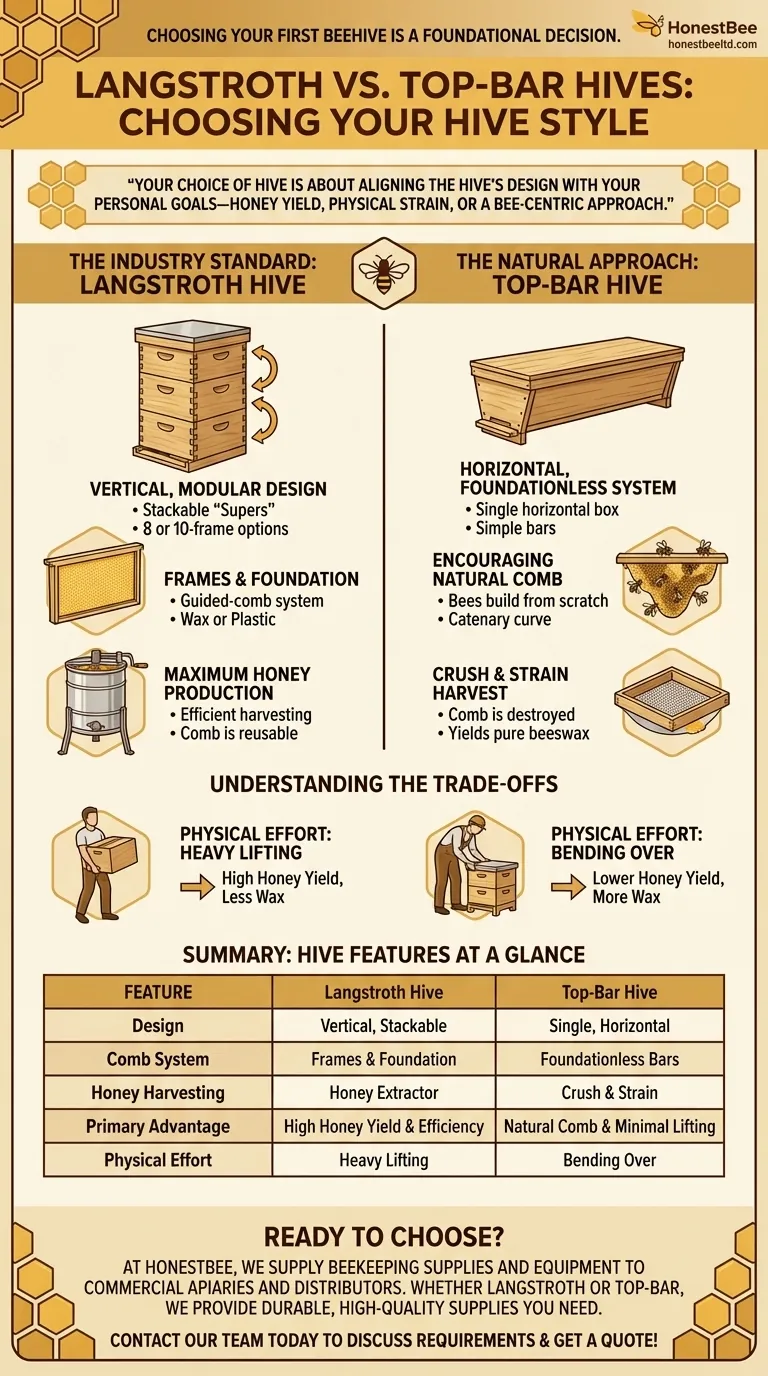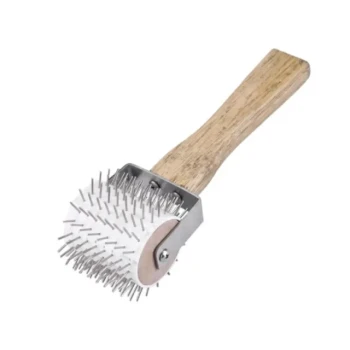Choosing your first beehive is a foundational decision that shapes your entire beekeeping experience. The two most dominant modern styles are the vertical, modular Langstroth hive, which is the commercial and hobbyist standard, and the horizontal Top-Bar hive, favored by those practicing a more "natural" style of beekeeping. Each design is built around a different philosophy of bee management and honey harvesting.
Your choice of hive is not about which is objectively "best," but about aligning the hive's design with your personal goals—whether that's maximizing honey yield, minimizing physical strain, or practicing a more hands-off, bee-centric approach.

The Industry Standard: The Langstroth Hive
The Langstroth hive, invented in the 1850s, is the most recognizable beehive in the world. Its design is the backbone of modern beekeeping.
Vertical, Modular Design
A Langstroth hive is a system of stackable boxes, often called "supers." The bottom boxes are for the brood (the queen and baby bees), while upper boxes are added for honey storage.
These hives typically come in 8-frame or 10-frame versions, referring to the number of frames that fit inside each box. The 10-frame is the traditional standard, while the 8-frame is lighter and easier to handle when full.
The Role of Frames and Foundation
Each box is filled with removable frames. Beekeepers install a "foundation"—a sheet of wax or plastic—into each frame to guide the bees.
Wax foundation is more natural but fragile. Plastic foundation is durable and pest-resistant, but bees can be slower to build on it unless it is coated in beeswax. This guided-comb system is the core of the Langstroth design.
Advantages for Honey Production
The standardized, removable frames are designed to work with a centrifugal honey extractor. This machine spins the honey out of the comb without destroying it, allowing the beekeeper to return the empty comb to the hive for the bees to refill quickly.
This efficiency is why the Langstroth is the undisputed choice for anyone focused on maximizing honey production.
The Natural Approach: The Top-Bar Hive
The Top-Bar hive is a much simpler design, consisting of a single, long horizontal box with bars laid across the top. It has gained popularity with hobbyists interested in a less intensive, more natural beekeeping method.
A Horizontal, Foundationless System
Instead of full frames, a Top-Bar hive uses simple wooden bars that span the width of the hive. Often, a small strip of wood or a line of melted wax on the underside of the bar encourages the bees to build straight.
Encouraging Natural Comb
Because there is no foundation, the bees build their comb from scratch, hanging it down from the top bar in a natural catenary curve. This is the primary appeal for "natural" beekeepers who want to interfere as little as possible.
How Honey is Harvested
Harvesting from a Top-Bar hive involves cutting the entire comb off the bar. The honey and wax are then separated by crushing the comb and straining the honey. This process destroys the comb, but yields pure beeswax as a valuable byproduct.
Understanding the Trade-offs
Neither hive is perfect. The best choice depends on what you are willing to compromise on.
Physical Effort: Lifting vs. Bending
A Langstroth hive requires heavy lifting. A 10-frame honey super can easily weigh over 60 pounds (27 kg). Inspections and harvests require you to unstack and restack these heavy boxes.
A Top-Bar hive eliminates heavy lifting, as you only ever remove one bar at a time. However, it requires more bending over the hive for inspections, which can strain your back.
Honey Yield vs. Natural Comb
The Langstroth is built for high honey yield. Reusing extracted comb saves the bees enormous energy, as it takes roughly eight pounds of honey to produce one pound of wax.
The Top-Bar hive produces less honey because the bees must constantly rebuild the comb that is destroyed during harvest. However, it provides a continuous supply of fresh, clean beeswax.
Standardization and Equipment
Langstroth components are highly standardized and widely available from nearly any beekeeping supplier. Accessories like frame-style division board feeders are designed specifically for this system.
Top-Bar hives are often DIY projects and can have non-standard dimensions, making it harder to find interchangeable parts or specific accessories.
Making the Right Choice for Your Goal
Select your hive based on your primary motivation for keeping bees.
- If your primary focus is maximizing honey production: The Langstroth hive is the undisputed choice due to its efficiency and compatibility with honey extractors.
- If your primary focus is natural beekeeping and minimal heavy lifting: The Top-Bar hive offers a less intrusive approach that aligns with the bees' natural comb-building instincts.
- If your primary focus is ease of finding equipment and educational resources: The Langstroth hive is the dominant standard, with a vast ecosystem of parts, tools, and community knowledge.
Understanding these fundamental design philosophies is the first step toward becoming a successful and confident beekeeper.
Summary Table:
| Feature | Langstroth Hive | Top-Bar Hive |
|---|---|---|
| Design | Vertical, stackable boxes | Single, long horizontal box |
| Comb System | Removable frames with foundation | Foundationless top bars |
| Honey Harvesting | Honey extractor (comb is reusable) | Crush & strain (comb is destroyed) |
| Primary Advantage | High honey yield & efficiency | Natural comb & minimal heavy lifting |
| Physical Effort | Heavy lifting of boxes | Bending over for inspections |
Ready to choose the perfect hive for your apiary?
At HONESTBEE, we supply beekeeping supplies and equipment to commercial apiaries and distributors through wholesale-focused operations. Whether you're standardizing with Langstroth equipment or sourcing components for Top-Bar hives, we provide the durable, high-quality supplies you need to succeed.
Contact our team today to discuss your hive requirements and get a quote!
Visual Guide

Related Products
- Long Langstroth Style Horizontal Top Bar Hive for Wholesale
- Professional Hive Top Bee Feeder for Beekeeping
- Telescopic Beehive Outer Cover Lid Roof with Galvanised Sheeting for Langstroth Hive and Beehive Outer Cover
- HONESTBEE Professional Hive Top Bee Feeder Feeding Solution
- Professional Galvanized Hive Strap with Secure Locking Buckle for Beekeeping
People Also Ask
- How does the design of a top bar hive benefit beekeepers? Ergonomic & Natural Beekeeping for Hobbyists
- What are the benefits of the top bar hive? A Guide to Ergonomic, Natural Beekeeping
- What are the benefits of a top bar hive? A Natural, Low-Impact Approach to Beekeeping
- How are entrances designed in top bar hives? Master Beehive Layout for Maximum Honey
- How does the top bar hive help control varroa mites? A Natural Approach to Mite Management



















